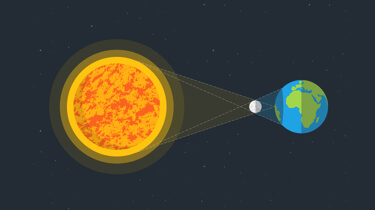 Exercise
Exercise
Tap all the highlighted words in the article below to see their definition. ⇩Get your protective glasses ready—it’s time for a solar eclipse!
Solar eclipse
A solar eclipse occurs when the Sun, Moon, and Earth line up in just the right way. As a result, the Moon blocks the light of the Sun from our view on Earth.
On June 21, a six-hour annular eclipse will be visible from parts of Africa, the Middle East, India, and China.
Types
When you think of a solar eclipse, you might picture the type in which the Sun is hidden completely. But there are actually four kinds: total, partial, annular, and hybrid.
Total
This is the most dramatic kind of eclipse, with the Moon hiding the Sun from our view completely. When a total eclipse happens, Earth darkens and temperatures may drop. Often, animals and birds get confused because they think it’s night.
Partial
A partial eclipse is when the Moon only covers the Sun, well, partially. This means that some of the Sun is still visible. Sometimes, a partial eclipse moves on to be an annular or total eclipse.
Annular
With this type, the Moon blocks most of the Sun, except its bright outer edge, or annulus. The result is called a “ring of fire.”
Hybrid
The rare hybrid eclipse can look like a total eclipse to some people, and annular to others—it depends on your location on Earth.

Fun facts
- Total solar eclipses can’t be seen from the north and south poles.
- Nearly identical eclipses happen every 18 years and 11 months.
- In ancient times, people used to think that solar eclipses meant the gods were angry.
- There are between two and five solar eclipses every year.
Watching an eclipse
You probably know you shouldn’t stare directly at a solar eclipse. Here are a few ways you can observe one safely:
- Wear eclipse glasses (make sure they’re specifically designed for eclipses!).
- Make a pinhole camera or pinhole mirror—you can find instructions online.
- Watch the interesting way a tree’s leaves make shadows on the ground.
See for yourself
If you’re lucky enough to be able to watch the annular eclipse on June 21, don’t forget to check it out—carefully, of course!
Eclipse of the Sun Comprehension
Share this Lesson 
Send it:

Today is the tenth of July. I will see it the next time
Thanks Andrea. This is an interesting article. Thanks for sharing.